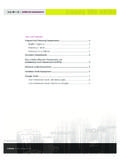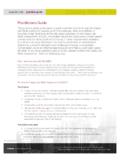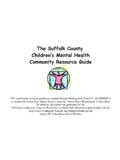Transcription of Promising Strategies Family Unification Program (FUP)
1 1 Promising Strategies Family Unification Program (FUP) **September 2011** Introduction The Family Unification Program (FUP) is a Program under which Housing Choice Vouchers (HCVs) are provided to families for whom the lack of adequate housing is a primary factor in the imminent placement of the Family s child or children in out-of-home care or the delay in the discharge of the child or children to the Family from out-of-home care. FUP vouchers may also be used for youths at least 18 years old and not more than 21 years old who left foster care at age 16 or older and who lack adequate housing. Public Housing Authorities (PHAs) administer FUP in partnership with Public Child Welfare Agencies (PCWAs) who are responsible for referring FUP families and youths to the PHA for determination of eligibility for rental assistance. The structure of the Family Unification Program , which requires the PHA and PCWA to work closely together, can make the successful operation of the Program challenging.
2 Additionally, there are relatively few PHAs that operate a FUP Program , which makes it difficult to create a shared knowledge base of successful practices. This document is meant to begin to create such a shared knowledge base. Below are Promising Strategies identified by a selected group of FUP PHAs as ways to improve workflow and establish a strong partnership between the PHA and PCWA, to better serve the FUP clientele. Methods In Fall of 2010 and Spring of 2011, HUD staff, along with a representative from the Department of Health and Human Services, met with PHA staff and their PCWA partners from six FUP sites to discuss the FUP Program . PHAs were selected to give variation in size, geography, and success in lease-up within the Program . The six PHAs that were selected are: 1. Southern Nevada Regional Housing Agency (NV018) 2. King County Housing Authority (WA002) 3. Fairfax County Redevelopment and Housing Authority (VA019) 4.
3 St. Paul Public Housing Agency (MN001) 5. Madison Community Development Authority (WI003) 6. Housing Authority of the City of Yuma (AZ035) 2 Promising Strategies 1. Collaboration Jointly create measurable goals and standards for success HUD employs utilization as the main metric for assessing the success of the FUP Program , but PHAs and PCWAs can create additional Program goals to measure their success. These goals should be measurable and have meaning to both the PHA and the PCWA. Goals and standards for success not only create ways to better evaluate Program progress, but can also be a useful document for potential funders for PCWA services. There are many aspects of the FUP Program that may act as the basis of goals and standards of success. Some Goals and Standards of Success are: o Goal: Ensure services, such as counseling, job training programs , and financial literacy courses, are available to and used by FUP participants, to prevent Family break-up.
4 Standard of Success: XX% of FUP families participate in the PCWA services provided. o Goal: Prepare FUP youth for success in unassisted housing Standard of Success: XX% of FUP youth are living in adequate housing after XX months of exiting the Program . o Goal: Train and empower FUP youth to find and maintain employment Standard of Success: XX% of FUP youth are employed within XX months of beginning the FUP Program . Collaboration in creating forms/processes Several PHAs and PCWAs that we spoke with worked together to create the workflow and appropriate forms for the FUP Program . This collaboration can be an excellent start to the relationship between the PCWA and PHA and should ideally start a month or more before funds are disbursed. Some of the forms that PHAs and PCWAs specifically mentioned as helpful are: o Referral Checklist: This lists the screening information that the PCWA should review prior to referring a client to the PHA.
5 O Referral Form: This form includes the name of the Family members, contact information, and date of birth, as well as the name of the Family s caseworker and the FUP Point of Contact. o Document Checklist: This form lists the documents that the FUP Family or Youth needs to bring to the PHA once the PCWA has referred them as FUP-eligible. Some of the PHAs and PCWAs also worked together in establishing a system of tracking referrals and gathering data which helped create a streamlined and consistent tracking process between agencies. Additionally, PHAs and PCWAs were able to identify together the need for specific data, and further strengthen the collaborative process among the agencies. 3 Regular Meetings and Training Another good way to encourage collaboration is to hold regular meetings between PCWA and PHA staff. These meetings will allow staff at both organizations to learn about processes, such as intake procedures at both the PHA and PCWA, and challenges, such as insufficient documentation from families, which are encountered in the FUP workflow.
6 Each of the PHAs and PCWAs that we talked to held regular meetings and most conducted these regular meetings between FUP liaisons and Points of Contact (POCs) at the PCWA. However, conducting larger meetings occasionally with PCWA and PHA staff may help further promote sharing of knowledge and ideas and create networking opportunities among staff from each of the agencies. Scheduling trainings that involve staff members from both the PHA and PCWA is another a good way to meet staff from the other organization and create greater understanding of each others programs , roles, and processes. Most of the agencies we met with held trainings with the FUP liaison(s); others also included PHA and PCWA Program directors or managers. In other cases the partnering agencies held an initial, larger training session with all appropriate staff and then conducted smaller training sessions, as needed, with FUP liaisons and/or Program directors or managers.
7 Some topics recommended for training are: HCV eligibility, PCWA identification of clients, and how PCWA supportive services are offered. 2. Referrals Process Point of Contact Each of the groups that we spoke with had established a Point of Contact (POC) at both the PHA and the PCWA, through which all FUP referrals were sent. Identifying a POC at both the PHA and PCWA became a requirement in the 2010 Notice of Funding Availability (NOFA). Establishing a lead in the FUP Program at both agencies allows for better communication, since there is no confusion about who is the right person to send inquiries. This also allows for faster resolution of any problems that arise, since the lines of communication are already open between the POCs. Additionally, having a POC at each location can assist in training teams, with the POC for the PHA training PCWA staff and vice versa. Eligibility Determination Prior to referral, the PCWA staff should perform a pre-screening of the client to see if they meet the PHA admission requirements.
8 It is important for the PCWA to perform pre-screening prior to referring a Family in order to minimize the number of referrals that do not qualify for HCV assistance, as this may increase frustration for the applicant and is an inefficient use of time for the applicant, the PCWA, and the PHA. The final HCV eligibility determination will continue to be performed by the PHA. Training of PCWA staff and other service providers that may identify potentially eligible FUP applicants to 4 the PCWA is also helpful in minimizing the number of referrals that do not meet FUP or general HCV Program requirements. Several PHAS created a pre-application eligibility determination worksheet or other intake application form for the PCWA to determine HCV eligibility. Some information that may be included on a pre-application eligibility determination worksheet includes: o Income limits by Family size o Age requirement o Criminal screening o Citizenship/Eligible immigration status o Alcohol/Drug use If a PHA determines that a Family or youth fails to meet the PHA s HCV eligibility requirements, PHAs should refer the Family back to the PCWA with information on why the client is not eligible under PHA rules.
9 If the reason for ineligibility is curable, such as a substance abuse issue that could be resolved through treatment, this should be noted so that the PCWA caseworker can help the client to meet this eligibility requirement. Referring the families back to the PCWA also serves to keep the Family /youth engaged in services to improve their current circumstances, regardless of whether they receive a FUP voucher. Ideally, a referral at this point would involve the POCs from the PHA and PCWA to ensure coordination between the two agencies. Partnering Agencies Most cities and towns have a variety of other service organizations that provide services to potential FUP participants; in order to make sure that the largest number of potential clients know about FUP, PHAs and PCWAs should educate these organizations about the FUP Program . For instance, one PHA we met with encourages area homeless shelters to refer families and youth who may qualify for a FUP voucher to its PCWA.
10 Other care providers may include domestic violence organizations, the local Continuum of Care, and organizations that work with at-risk youth. 3. Operations Orientation Orientation can be somewhat overwhelming for participants. Several PHAs reported that PCWA representatives attended training with the FUP families and youth, which provided a means of support and assistance in transitioning the case to the PHA. Alternatively, a good way to provide seamless, coordinated service between the PCWA and PHA is to hold a joint orientation service once the Family or youth is accepted into the FUP Program . This will allow the PCWA to provide any assistance programs concerning lease-up at the same time as the rules of the voucher are explained. The presence of a PCWA case manager may also allow for clearer and more effective 5 conversation between the FUP participant and the PHA. Use of Technology Several agencies indicated that it is sometimes difficult to reach families or youths because many lack a fixed residence.















